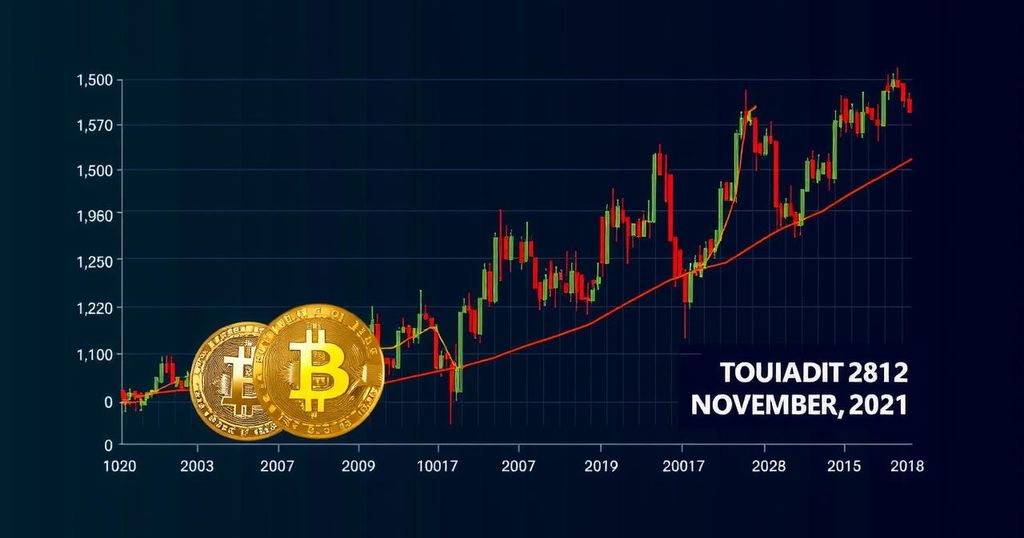Factors Influencing Bitcoin’s Price: A Look Ahead
Bitcoin experiences considerable price fluctuations, largely influenced by market sentiment rather than fundamentals. Key factors affecting its future trajectory include the US presidential election, monetary policy adjustments, the state of the US economy, and the potential sale of significant Bitcoin reserves by the government. Analysts are closely observing these elements to predict Bitcoin’s movement.
The price trajectory of Bitcoin remains characterized by significant volatility throughout the year, oscillating between downturns and tentative recoveries. Analysts from GSR contend that this unpredictability is predominantly influenced by market sentiment rather than underlying fundamentals. Current discussions among market analysts have identified four primary factors that may significantly impact Bitcoin’s future price movements. Firstly, the unfolding political landscape surrounding the US presidential election is crucial. Former President Donald Trump, known for his pro-cryptocurrency stance, has suggested a potential reevaluation of leadership at the Securities and Exchange Commission, including the removal of Chair Gary Gensler, alongside the establishment of a Bitcoin reserve. In contrast, the position of Vice President Kamala Harris on cryptocurrency remains less defined. Additionally, concerns about a contested election could introduce economic uncertainties. Adam Guren, Chief Investment Officer at Hunting Hill, presented a perspective where a contested election could lead to a recession or economic slowdown, potentially leading to rate cuts that might bolster Bitcoin’s value alongside other risk assets. Secondly, monetary policy actions taken by banks could either support or hinder Bitcoin’s ascent. Historically, injections of liquidity have propelled risk assets upward, with analysts specifically monitoring actions from the US Federal Reserve and the Bank of Japan. The prevailing expectation is a rate cut from the Fed this November, which, if supported by favorable economic indicators, could favorably affect Bitcoin’s price. Concurrently, developments in Japan, which hint at gradual interest rate hikes, could provoke considerable fluctuations in cryptocurrency values. The third influential factor is the current state of the US economy. Recent mixed economic signals, although indicative of stabilizing conditions—such as job growth—are tempered by declines in consumer confidence. While some analysts anticipate a soft economic landing, which could serve as a positive stimulus for Bitcoin, adverse sentiments rooted in potential recession fears still pose a risk by prompting shifts toward safer asset classes. Lastly, a potential sale by the US government of approximately 69,000 Bitcoin—valued at around $4.2 billion, linked to the Silk Road investigation—could exert considerable downward pressure on Bitcoin prices. The Supreme Court’s decision not to hear appeals connected to this case allows for this sale to proceed. As highlighted by Brian Rudick from GSR, the ramifications could mirror the market turmoil experienced with earlier disbursements related to Mt. Gox, resulting in increased volatility depending on how the sale is conducted.
The dynamics affecting Bitcoin’s price are complex, blending sentiment-driven market behaviors with external economic and political factors. The cryptocurrency market notoriously exhibits high volatility; thus, market participants closely monitor events that could lead to significant price shifts. The upcoming US presidential election, monetary policy adjustments by central banks, the broader economic landscape, and legally significant cryptocurrency holdings by governmental bodies are currently pivotal areas of focus. Analysts are tasked with discerning how these variables interact to influence investor sentiment and behavior in the marketplace, particularly regarding Bitcoin, which is emblematic of the broader digital asset environment.
In summary, Bitcoin’s price is poised for fluctuation, driven by a convergence of market sentiment and external influences. Key considerations include the potential outcomes of the US presidential election, shifts in monetary policy by central banks, indicators from the US economy, and the looming sale of seized Bitcoin. Each of these elements will likely play a crucial role in shaping the future trajectory of Bitcoin’s price, indicating a landscape where informed and vigilant investor strategies will be paramount.
Original Source: www.dlnews.com







Post Comment